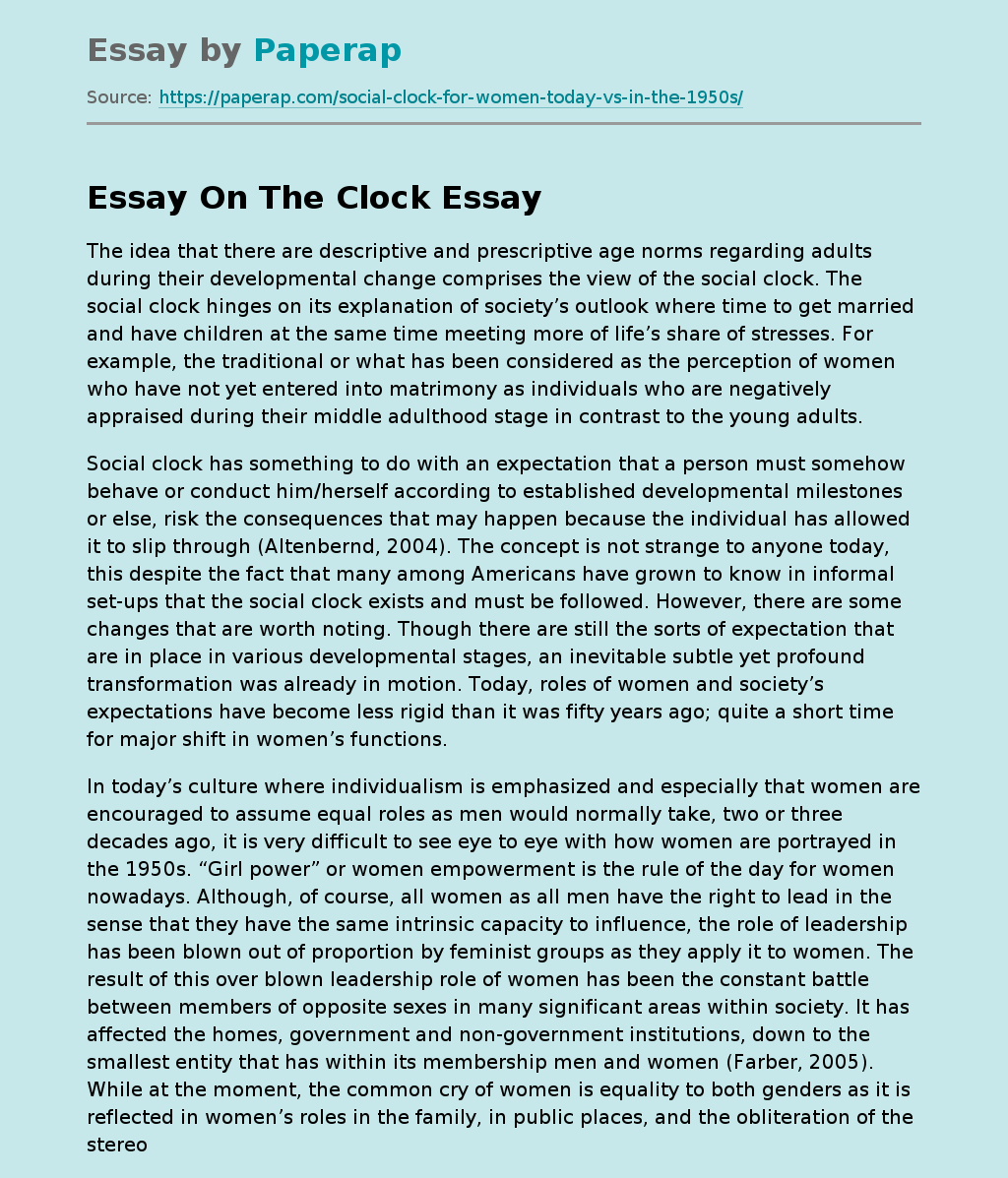Essay On The Clock
The idea that there are descriptive and prescriptive age norms regarding adults during their developmental change comprises the view of the social clock. The social clock hinges on its explanation of society’s outlook where time to get married and have children at the same time meeting more of life’s share of stresses. For example, the traditional or what has been considered as the perception of women who have not yet entered into matrimony as individuals who are negatively appraised during their middle adulthood stage in contrast to the young adults.
Social clock has something to do with an expectation that a person must somehow behave or conduct him/herself according to established developmental milestones or else, risk the consequences that may happen because the individual has allowed it to slip through (Altenbernd, 2004). The concept is not strange to anyone today, this despite the fact that many among Americans have grown to know in informal set-ups that the social clock exists and must be followed.
However, there are some changes that are worth noting. Though there are still the sorts of expectation that are in place in various developmental stages, an inevitable subtle yet profound transformation was already in motion. Today, roles of women and society’s expectations have become less rigid than it was fifty years ago; quite a short time for major shift in women’s functions.
In today’s culture where individualism is emphasized and especially that women are encouraged to assume equal roles as men would normally take, two or three decades ago, it is very difficult to see eye to eye with how women are portrayed in the 1950s.
“Girl power” or women empowerment is the rule of the day for women nowadays. Although, of course, all women as all men have the right to lead in the sense that they have the same intrinsic capacity to influence, the role of leadership has been blown out of proportion by feminist groups as they apply it to women. The result of this over blown leadership role of women has been the constant battle between members of opposite sexes in many significant areas within society. It has affected the homes, government and non-government institutions, down to the smallest entity that has within its membership men and women (Farber, 2005). While at the moment, the common cry of women is equality to both genders as it is reflected in women’s roles in the family, in public places, and the obliteration of the stereotyped designation of females in past decades which until now has its bearing in the minds of the general public the consequent outcome of this campaign is prevalent in almost every area where function is concerned.
In the late 1960s, women’s movement began to blossom. It was stirred by the then sentiment of repulsion to the tasks being typecasted among women. Women’s movement of the 60s aimed to question the menial duties relegated to women such as getting married, becoming a housewife and afterwards attending to household chores (including raising children), and when outside opportunity comes for them to work, they’re consigned to answering phones, photocopying, etc (Farber, 2005). The scenery has been changed and is no longer the same as in the past 30 or 40 years. The typical woman today is one that is among the working class – no longer confined to house premises, but working and providing as much as her male counterparts. She can be the manager or an executive of an established firm where most of the male employees are under her command. Equality in roles has now been achieved. However, instead of seeing male and female partnership as complimentary to both sexes, the danger of too much emphasis on equality especially when it is defined merely in domestic and public functions is the threat that masculinity poses to womanhood. It is good for women to fight for their basic equal rights with men as members of this global community, but if it results in certain imbalances because the aim has become the dethronement of the opposite gender, then the battle for equality has now turned into fight for superiority of the female sex.
Essay On The Clock. (2019, Dec 05). Retrieved from https://paperap.com/social-clock-for-women-today-vs-in-the-1950s/

